Most of us, myself included, spend a significant portion of our day sitting — usually on chairs or couches. Sitting all day long isn’t great for our health, but if possible, switching to sitting on the floor (even just for short periods of time) actually can help improve our overall health. That’s because the movements required to get into and out of a sitting position on the floor require developing strength, mobility, and coordination.
As body alignment specialist Lauren Roxburgh told Well + Good last year, “When you are able to sit down and stand back up from the floor with relative ease, it’s a wonderful sign of overall structural, skeletal health, and muscular balance and alignment.”
The sitting-rising test is a good measure of strength and mobility
The sitting-rising test, where you cross your left leg over your right, then lower yourself into a cross-legged sitting position, then rise out, serves as a good measure of your strength, mobility, and coordination. (You can watch a demonstration here.)
As a 2012 study found, people between the ages of 51 and 80 who were able to successfully do the sitting-rising test lived longer than those who couldn’t, most likely because it’s a good measure of a person’s overall strength and mobility, which is often lost with age.
If you can’t do the sitting-rising test successfully, this doesn’t mean you are doomed to die an early death. However, if you struggle to do the sitting-rising test, then that should serve as a reminder to work on your overall strength and mobility, which will become increasingly important for maintaining good health as you get older.
The good news is that this is a skill that can be actively worked on and improved. One way to do this is to get into the habit of sitting on the ground, the frequency of which will make the transition easier.
The benefits of sitting on the ground
Some of the benefits of sitting on the ground include developing body stability; increased hip mobility, which can get tight from sitting in a chair; increased flexibility and mobility of your lower body; and active engagement of your muscles.
What to avoid
Although sitting on the ground can help improve your health, this may not be for everyone. As with everything, it’s important to listen to your body, and to adjust as needed.
Some of the risks of sitting on the ground include putting increased strain on joints, reduced blood circulation, or exacerbating existing joint issues. It’s also important to watch your posture and to avoid slouching your back.
If you are dealing with injuries, or if sitting on the ground is too painful, then you’ll either want to adjust your position, or ask a medical professional about any concerns you might have.

Leave a Reply
You must be logged in to post a comment.